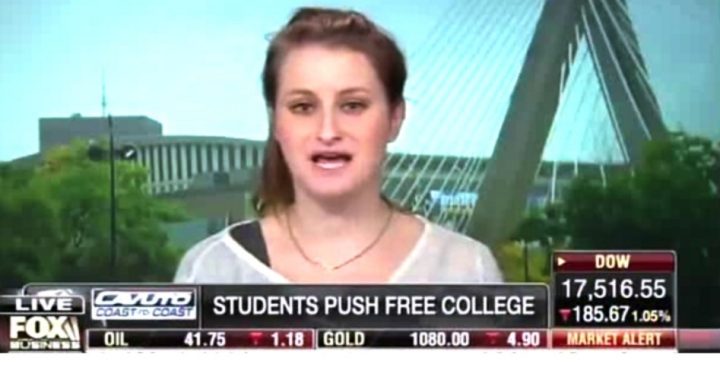
It seems one cannot turn on the news today without hearing about the latest cause around which college students are rallying. On Thursday, it was student loan debt for higher education, albeit a cause behind which most people can line up. Unfortunately, the protestors’ solution to the problem is tuition-free public colleges, missing the mark and revealing once more the poor quality of their economics education.
Reuters reports that marches took place at Texas State, the University of Massachusetts, Depaul University in Chicago, and Northeastern University.
The protestors also marched to demand minimum-wage hikes for campus workers. The demonstrations took place just two days after thousands of fast-food workers rallied nationwide to push for a $15 minimum wage and union rights.
Among the list of the student protestors’ demands were tuition-free public colleges, cancellation of all student debt, and a $15/hour minimum wage for campus workers.
Data reveals that student loan debt has grown at astronomical levels. According to the U.S. Consumer Financial Protection Bureau, the total volume of outstanding U.S. student loan debt has doubled from $600 billion in 2006 to $1.2 trillion today.
“I want to graduate without debt,” said Ashley Allison, a 22-year-old student at Boston’s Bunker Hill Community College, at the Northeastern rally. “Community college has been kind to me, but if I want to go on, I have to take on debt.”
Does Allison think she is alone on this? On a personal note, I would have thoroughly loved to have graduated without any debt. All debt-ridden college graduates would have. But in the years since my graduation date, I have worked diligently to chip away at my massive school debt, and it has made me a better person because it taught me the value of a budget. And thanks to the federal government’s policies that have resulted in enormous inflation, it was not always easy as the dollar does not accomplish what it used to. When you have tens of thousands of dollars in debt, that can prove to be troublesome.
The protesting students are interested in circumventing this difficult reality by demanding that someone else pay for it. “The student debt crisis is awful. Change starts when people demand it in the street. Not in the White House,” said Elan Axelbank, 20, a third-year student at Northeastern, who claims to be a co-founder of the national action.
Unfortunately, Axelbank is wrong. Change does indeed start with the federal government because it is the federal government’s intrusion in higher education that made college so expensive in the first place.
It’s also worth at least a polite nod to the law of our land to point out that there is no authorization in the Constitution for the federal government to fund college education.
But there is also no constitutional authorization for the federal government to fund elementary or secondary education, and this has not stopped the federal government from doing it.
And let’s face it, these are college students. Do any of them care about the Constitution anymore? A quick glance at the daily news stories points to a resounding “nope.”
As is usual with the Left, the road to hell is often paved with “good intentions,” and the liberal agenda often leaves accidental victims in its wake. The CATO Institute observes that asking the American people to fund college education ultimately amounts to asking low and average income earners to pay to educate future high-income learners:
For one thing, such subsidies benefit people who will earn higher than average incomes during their careers. Thus, the effect of subsidy programs, in part, is to impose taxes on blue collar workers, who have not attended college, to pay for the tuition of future white-collar professionals. Why should the government subsidize future high earners at the expense of average working people?
In other words, the very people that the students are allegedly marching to defend, low-income wage earners, would have to help contribute to the college funds of students who will graduate and earn significantly more than those who paid for it.
What’s worse is that federal subsidies have historically served to increase education costs. Peter Wood, a professor at Boston University, noted that federal subsidies “are seen by colleges and universities as money that is there for the taking…. Tuition is set high enough to capture those funds and whatever else we think can be extracted from parents.” So not only will low and average wage earners be asked to foot the bill for college tuition, they’ll likely have to do it at a significantly higher rate.
Besides this obvious violation of the purported liberal agenda, taxpayer-funded education will do to college what ObamaCare has done to healthcare: dissolve it of any quality or value. The Cato Institute writes,
Even with its problems, the American postsecondary education system is considered to be the best in the world. Driven by freedom of choice by consumers and competition between independent institutions, it has unmatched vibrancy. However, increasing top-down control and subsidization from Washington is creating a threat to the strength of the American system.
As we have seen in K-12 education, the growth in federal subsidies is usually accompanied by calls for more oversight, micromanagement, and rising levels of red tape imposed by Washington.
Furthermore, some critics call into question whether increased college enrollment, which could result from offering free education, denotes automatic success. The CATO Institute writes that despite the increase in college enrollment over the last few decades, there has been a decline in aptitude:
Many of those additional students may not have been ready, or suited, for college. As evidenced by the rising shares of college students who require remedial work. Further evidence of the problem is that institutions have lowered their standards to adapt to the rise in second-rate students. The American Academy of Arts and Sciences reported that from the mid-1960s to the mid-1990s, college grade point averages grew steadily but Scholastic Aptitude Test scores declined. The share of entering college students who complete degrees has also fallen over the decades.
Still, it is easy to sympathize with the plight of college students. They still wear rose-colored glasses and believe their career possibilities are endless, blissfully unaware of the true nature of the job market. And the jobs that are available often fall short of what one would need to pay off the types of payments associated with student loan debt. They are truly in for a rude awakening, and for that, they deserve sympathy.
What’s more, if they think student loan debt is bad, wait until they see their healthcare premiums when they begin their careers. Oh, you didn’t know that you were going to have to foot the healthcare bill for those low-wage workers you marched for in college? What are they teaching you in these schools?




